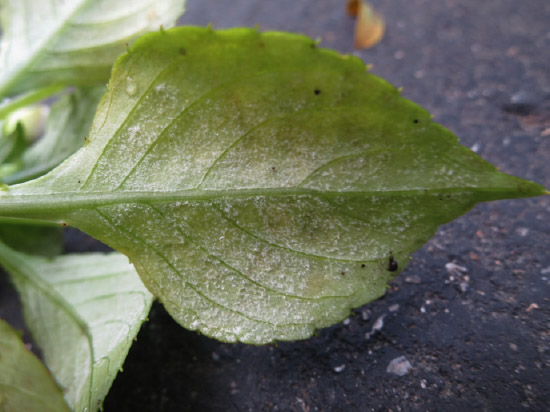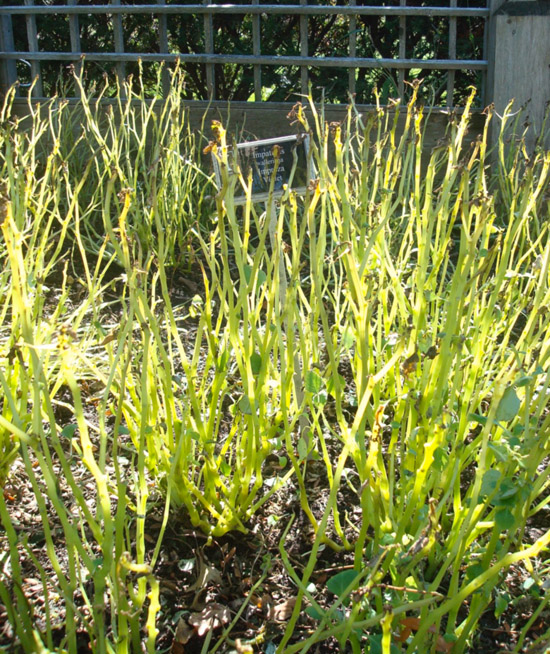Issue 3, May 19, 2014
Impatiens Downy Mildew
Impatiens Downy Mildew (IDM) continues to threaten one of the most popular shade-tolerant bedding plants used in American landscapes. At one point, impatiens was the number one bedding plant sold in the United States. However, as a result of IDM, many growers have opted to cut back on the number of impatiens grown or avoid them all together.
IDM is a caused by the fungal-like pathogen, Plasmopara obducens. The disease primarily infects garden impatiens (Impatiens walleriana) while New Guinea Impatiens (Impatiens hawkerii) and related hybrids have a high resistance to the disease. IDM was first reported in U.S. production greenhouses during the 2004 growing season. Several years later, beginning in 2011, the disease appeared in U.S. landscapes with outbreaks occurring again in 2012 and 2013. At this point, everyone is likely well aware of the devastating impacts of this disease. IDM is an aggressive disease and has the ability to overwinter in the soils of previously infected planting beds. As a result, infections can occur even when growers provide clean disease-free plants. Unfortunately, the cold, harsh winter is not expected to impact the pathogen’s survival. The disease is expected to continue to be problematic in 2014.
Alternatives to Impatiens walleriana have been heavily promoted for use in the landscape. Most retail greenhouses and garden centers provided suggestions for suitable alternatives. Michigan State also published a fact sheet titled, Alternatives to Impatiens. The substitutes, though attractive, don’t offer the same features and color impact as traditional impatiens. Those willing take the risk continue to plant impatiens in select areas. If planting impatiens this year, use additional precautions and keep a careful watch to catch this disease in the early stages. Suggested precautions include:
- Start with clean, healthy transplants.
- Choose planting beds in open areas. Avoid planting impatiens in the same areas year to year.
- Avoid dense, overcrowded plantings.
- Keep the foliage dry. Avoid wetting the foliage while watering.
- Scout plantings on regular basis for IDM. Scouting and early detection is critical with this disease.
When scouting, look for the following symptoms:
- Initial symptoms are subtle and start as light-green yellowing or stippling of leaves (Photo 1).
- Infected leaves may curl downward.
- A white downy-like growth may be visible on the undersides of infected leaves (Photo 2).
- Infected leaves eventually drop leaving a bare stem (Photo 3).
- Under cool wet conditions, infected stems may collapse.

Photo 1. Impatiens walleriana with yellowing leaves (center plant) caused by Impatiens Downy Mildew.

Photo 2. White downy –like growth on the underside of a leaf infected with Impatiens Downy Mildew.

Photo 3. Planting of Impatiens walleriana defoliated by Impatiens Downy Mildew.
If you suspect that your impatiens may be infected with IDM, it is important that you remove and destroy infected plants as soon as possible. Bag the infected material, including any fallen leaves or blossoms, as well as any of the nearby Impatiens (they may be infected too),
and remove from the site. Composting the diseased material is not recommended. The pathogen produces structures capable of overwintering in the Midwest. Composting may not completely destroy the pathogen. Avoid replanting a previously infected location with susceptible impatiens. If you have struggled with this disease in years past, your only option is to consider planting other shade tolerant species. Fungicides can provide some protection when applied preventatively on an appropriate schedule with a rotation of active ingredients. However, homeowners have fewer fungicide options when compared to commercial applicators and may not be able to protect impatiens for the entire season. Therefore, we do not recommend that homeowners rely on fungicides for control of IDM. (Travis Cleveland)
Author:
Travis Cleveland